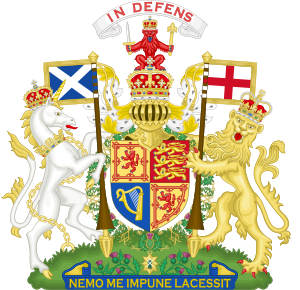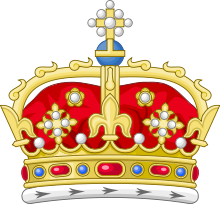- Crown of Scotland
-
The Crown of Scotland is the crown used at the coronation of the monarchs of Scotland. Remade in its current form for King James V of Scotland in 1540, the crown is part of the Honours of Scotland, the oldest set of Crown Jewels in the United Kingdom. The crown dates from at least 1503 when, in an earlier form, it was depicted in the portrait of James IV of Scotland in the Book of Hours commissioned for his marriage to Margaret Tudor.
Contents
Manufacture
In January 1540, King James V commissioned the royal goldsmith, John Mosman, to refashion the Crown of Scotland. The existing crown was delicate and had been repaired at least twice in the previous 30 years, and a 1539 inventory showed further damage, including the loss of one fleur-de-lis. Mosman dismantled the old crown and removed its stones and pearls. The crown was melted down and Mosman added 41 ounces of gold mined at Crawford Moor in Lanarkshire.
Constructed of solid gold, the crown consists of a base, with four fleur-de-lis alternating with four strawberry leaves. The four arches of the crown are decorated with gold and red oak leaves. At the intersection of the arches is a golden monde, painted blue with gold stars. The monde is surmounted by a large cross decorated in gold and black enamel and pearls. The crown is encrusted with 22 gemstones, including garnets and amethysts, 20 precious stones and 68 Scottish freshwater pearls.
James V ordered a purple and ermine bonnet from tailor Thomas Arthur of Edinburgh to fit inside the crown. James VII ordered the colour of the bonnet be changed to red. The bonnet had to be replaced several times, and the present bonnet was made in 1993. The completed crown weighs 1.64 kg (3 lb 10 oz).
Usage
 The Royal Arms of the United Kingdom used in Scotland, with the Crown of Scotland in prime position on the helm, upon the lion sejant affronté on the crest and upon the unicorn supporter. The crown upon the lion supporter is St. Edward's Crown, which has been a symbol of Royal Authority throughout the Commonwealth since 1953.
The Royal Arms of the United Kingdom used in Scotland, with the Crown of Scotland in prime position on the helm, upon the lion sejant affronté on the crest and upon the unicorn supporter. The crown upon the lion supporter is St. Edward's Crown, which has been a symbol of Royal Authority throughout the Commonwealth since 1953.
The crown was first worn by James V to the coronation of his second wife, Mary of Guise, as queen consort at Holyrood Abbey, Edinburgh, in the year of its manufacture. It was subsequently used in the coronations of the child monarchs Mary, Queen of Scots, in 1543 and her son James VI, King of Scots, in 1567.
In the absence of a resident Scottish monarch following the Union of the Crowns in 1603, when James VI inherited the throne of England and moved his Royal Household from Edinburgh to London, the Honours were carried to sittings of the Parliament of Scotland to symbolise the sovereign's presence and the Royal Assent to legislation.
The crown was used for the Scottish coronation of both Charles I in 1633 and Charles II in 1651. However, no subsequent Scottish monarchs were crowned with the crown.
During the Civil War, having already destroyed the ancient English Crown Jewels, Oliver Cromwell sought to destroy the Scottish Crown Jewels. However, the Honours were secretly buried until the monarchy was restored in 1660.
Following the Act of Union of 1707, which unified the Kingdom of Scotland and the Kingdom of England to form the Kingdom of Great Britain, and having no ceremonial role to play in the proceedings of the new Parliament of Great Britain in London, the Honours were locked away in Edinburgh Castle. There they remained all but forgotten in a chest until 1818, when a group of people including Sir Walter Scott set out to find them. Since 1819 they have been on display in the Crown Room of Edinburgh Castle from where they are removed only for state occasions. The first was when presented to King George IV, at the Palace of Holyroodhouse in 1822, during his visit to Scotland (the first visit to Scotland by a reigning monarch since 1651).
On 24 June 1953, following her Coronation at Westminster Abbey, the crown was carried before Queen Elizabeth II of the United Kingdom in a procession from the Palace of Holyroodhouse to the High Kirk of St Giles, Edinburgh, where the Honours of Scotland, including the crown, were presented to The Queen during a National Service of Thanksgiving.
More recently, the crown has been present at the Official Opening ceremonies of sessions of the Scottish Parliament, including the first meeting of the modern Parliament in 1999[1] and the official opening of the new Scottish Parliament Building in 2004.[2] On such occasions the crown, carried by the Duke of Hamilton, the hereditary bearer of the Crown of Scotland, immediately precedes Her Majesty The Queen in the custom of the ancient opening ceremonial procession known as the Riding of Parliament.
As well as appearing in Scottish versions of the Royal Cypher and Royal Coat of Arms, including the version of the arms used by the Scotland Office, stylised versions of the crown appear upon the badges of the Royal Regiment of Scotland, The Royal British Legion Scotland, those of the Scottish Police Forces, the Scottish Ambulance Service, and upon the logos of the Crown Office and Procurator Fiscal Service, RCAHMS, and General Register Office for Scotland. A version of the crown is used upon Royal Mail premises, vehicles and Scottish pillar and wall boxes.
References
See also
External links
Crowns: St Edward's Crown · Imperial State Crown · George IV State Diadem · Crown of Scotland · Crown of Mary of Modena · State Crown of George I · Coronet of Frederick, Prince of Wales · Coronation Crown of George IV · Crown of Queen Adelaide · Small diamond crown of Queen Victoria · Crown of Queen Alexandra · Coronet of George, Prince of Wales · Crown of Queen Mary · Crown of Queen Elizabeth · Coronet of Charles, Prince of WalesSceptres: Swords: Precious stones: Cullinan Diamonds · Koh-i-Noor · Black Prince's Ruby · Stone of Destiny · St Edward's Sapphire · Stewart SapphireJewels by country: Other: See also Crowns English, Scottish, Welsh
and British crowns
(by chronology)Palatine Crown · Crown of Scotland · St Edward's Crown · Crown of Mary of Modena · State Crown of George I · Coronet of Frederick, Prince of Wales · Coronation Crown of George IV · Crown of Queen Adelaide · Imperial State Crown · Small diamond crown of Queen Victoria · Crown of Queen Alexandra · Coronet of George, Prince of Wales · Crown of Queen Mary · Imperial Crown of India · Crown of Queen Elizabeth · Coronet of Charles, Prince of WalesHoly Roman Empire,
German, Austrian,
Bohemian
and Italian crownsIron Crown of Lombardy · Reliquary Crown of Otto II · Crown of Otto III · Reliquary Crown of Empress Cunigunde · Reliquary Crown of Henry II · Imperial Crown of the Holy Roman Empire · Salian Funeral Crowns of Spires · Kamelaukion of Frederick II or Constance of Sicily · Reliquary Crown of Charlemagne (14th century) · Crown of St. Wenceslas (Bohemian lands) · Crown of Blanche of Valois (Bohemian lands) · Electoral Hat of Saxony · Ducal hat of Styria · Archducal hat (Archducal hat of Tyrol · Archducal hat of Joseph II) Crown of the Grand Duchy of Tuscany · Imperial Crown of Austria · Crown of Frederick I (Prussia) · Crown of Charlotte (Prussia) · Imperial Crowns of Charles VII · Napoleonic Crown of Italy · Royal Crown of Bavaria · Royal Crown of Württemberg · Royal Crown of Hanover · Grand Ducal Crown of Baden · Crown of Empress Elizabeth (Austria) Crown of Wilhelm I (Prussia) · German State Crown · Crown of Wilhelm II (Prussia)Polish crowns Crown of Bolesław I the Brave · Swedish Crown · Muscovy Crown · Hungarian Crown · Homagial Crown · Funeral Crown · Queens Crown · Crown of Augustus II · Crown of Augustus III · Crown of Maria Josepha · Płock DiademRussian crowns "Cap of Monomakh" · Crown of Kazan Tzardom · Crown of Tsar Michael Fyodorovich · Cap of Monomakh of the second set · Diamond crown of Tsar Peter I · Diamond crown of Tsar Ivan V · Altabas crown of the third set · Crown of Empress Catherine I · Crown of Empress Anna Ivanovna · Great Imperial Crown · Maltese Crown · Small Imperial CrownFrench crowns Crown of Charlemagne · Sainte Couronne · Crown of Louis XV · Crown of Napoleon I · Crown of Charles X · Crown of Napoleon III · Crown of Empress EugenieOther European crowns Crown of Crown Prince Carl (Norway) · Crown of Christian IV (Denmark) · Crown of Christian V (Denmark) · Crown of Zvonimir (Croatia) · Crown of Eric XIV (Sweden) · Crown of William I (Netherlands) · Crown of William II (Netherlands) · Crown of Norway · Crown of Portugal · Crown of the Queen of Norway · Crown of Elisabeta (Romania) · Crown of Maria (Romania) · Holy Crown of Hungary (Hungary) · Crown of Peter I (Serbia) · Crown of Martin of Aragon · Royal Crown of Spain · Crown of Greece · Papal Tiara · Crown of Rus (Ukraine) · Steel Crown of RomaniaNon-European crowns Crown of Faustin I (Haiti) · Empress Crown (Iran/Persia) · Great Crown of Victory (Siam/Thailand) · Kiani Crown (Iran/Persia) · Imperial Crown of Brazil · Imperial Crown of Mexico · Crown of Sri Vikrama Rajasinha of Sri Lanka · Pahlavi Crown (Iran/Persia) · Crown of Silla (Korea) · Crown of Hawaii · Crown of Tahiti · Crown of Madagascar · Crown of Ranavalona III · Silver crown of Emperor Tewodros (Ethiopia)See also Coronation · Crown Jewels · Heir Apparent · Heir Presumptive · King · Monarchy · Queen · Regalia · Royal FamilyRoyal heraldry in the United Kingdom United Kingdom Royal coat of arms · Royal Standard · Cadency labels of the Royal Family · Imperial State Crown · The Lion and the Unicorn
England Royal Arms · Royal Standards · Honi soit qui mal y pense · Dieu et mon droit · St Edward's Crown · Royal Supporters · Tudor rose · College of ArmsScotland Royal coat of arms · Royal Standard · Nemo me impune lacessit · In My Defens God Me Defend · Crown of Scotland · Court of the Lord LyonWales Monarchy of the United Kingdom · Heraldry Crown jewels by country Austria · Brazil · Czech Republic · Denmark · France · Germany (Bavaria · Prussia) · Greece · Hungary · Holy Roman Empire · Iran · Ireland · Japan · Malaysia · Madagascar · Netherlands · Nigeria · Norway · Poland · Romania · Russia · Serbia · Spain · Sweden · Thailand · United Kingdom (Scotland · Wales)Former or historical sovereign states shown in italics
Wikimedia Foundation. 2010.


